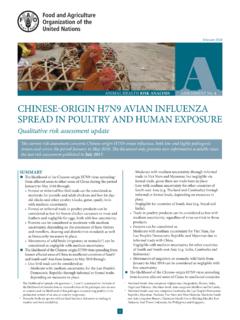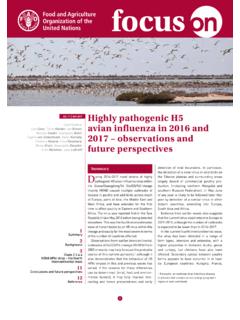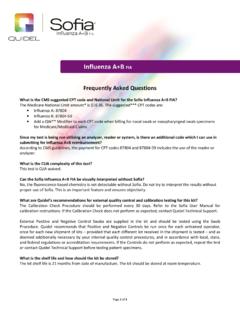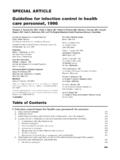Transcription of OSHA3327 INFLUENZA PAN forPRINT
1 He xav alentCh romiumOSHA3373-102009 OccupationalSafetyandHealthActof1970 T o ass uresafeandheal thful workingcondi tionsforwor king menandwomen;byauthorizingenfo rcementofthestandardsdeveloped undertheAct; by assistingandencouragingth e Statesintheir effort s toassuresa feandheal thfulworkingconditions;byproviding forre se arch, information,educ at ion,andtraininginth e fieldofoccupationalsaf et y andhealth. Thispublicationprovides a generaloverviewofapartic ularst andards-relatedtopic. This publicationdoesnot al terordeterminecomplianceresponsibil itieswhicharesetfor thinOSHA standards,andtheOc cu pati on al Safetyand Healt h Act. Moreover,becauseinterpr etationsandenforcementpolic ymaychangeovertime,foradditionalguidance onOSHA complian cerequi rements,th e readershouldconsultcurrentadministrat iv e interpretationsanddeci ainedin this publicationis in thepublicdomainandmaybereproduced,fullyo rpartially, informatio n willbemadeavailableto sensoryimpairedindivi :(202)693-1999;teletypewriter(TTY) DepartmentofLaborOccupationalSafetyandHe alth AdministrationOSHA3373-102009He xa valentCh romium2 Con ten tsIntr oduction.
2 3 Work er Exp os ure an d Healt h Con se quenc es .. 5 OSH A s He xa va len t Ch ro miu m St andards .. 5Ex pos ure Limits.. 6Ex pos ure Mon itoringand De termina tions .. 6 Scheduled Mo nitoring Opt io n .. 7Re gul at ed Areas.. 10 Cont ro l Mea sure s .. 10Re qui rements fo r Pro tect ive Wor kCl ot hi ng and Equipment .. 12Hy gi ene Areasan d Practice s .. 14 Hous ek eep ing .. 15Me di ca l Sur veilla nc e .. 16 Work er Tra iningan d Co mmu ni ca tion .. 19Re cor dkee ping .. 20Ef fec tiv e Dates.. 22 Addi ti onal Informati on .. 22Re fe re nce s .. 23 OSH A Ass is tance.. 24 OSH A Re gion al Offi ces .. 28 Int rod uctionThisdocument is intendedtosupplementOSHA sSmallEntityComplianceGuidefortheHexaval entChromiumStandardspublishedin2006(seeA dditi onalInformationsectionforweblinkto thisdocument)andtogi vereaders anoverviewoftheprovisionsandre quirementsoftheHexavalentChromiumstandar dsforgeneralindustry( ), shipyards( ),and construct io n ( ).
3 hexavalent ch ro mium(C r(VI) ) is a to (VI) is wid elyusedinpigments, metalfinishing(electroplating),woodprese rvativesandfungicides,andinchemicalsy onthenextpage lis ts some selectedCr(VI)compoundswiththeirsynonyms and ch ro miummayalsobepresentin fumesgeneratedduringtheproductionorweldi ngof chrome alloys. Chromiummetalis of tenalloyedwi thothermetal s a maj orconsumerofchromiummetal bookl etis in tended to provideinformationabouttheHexavalentChro miumst andardsfo r general industry(2 9 ),shipyards( ), andconstruction( ). TheOccupationalSafety and He al th Actre quiresemployerstocomplywithsafetyandheal thst andardspromulgatedbyOSHAor by a statewi thanOSHA-approvedstatepl ,thi s bookletis notit selfa standard or regulation,and it cr eatesno newlegalobligatio ,th erehasbeena declineintheuseofchr omatesinpigments forpaintsandcoatings;printing in ks;ceramic,glassandconstruction materials;roofingandplastic s.
4 Employersaresubsti-tutingless to xicinorganic andorganicpigments where possible(SRIC onsu lt ing, 2008).Table1. Selected Cr(VI ) Comp oundsan d Thei r Uses4Ch em ical Nam eChro miumTrioxideLeadChro mateSodiu mDichromateZin c Chro mateSyn on ym sChro mic ac id ,chr omia, chr omic(VI) acid, chromictri oxi de,chromiumoxide, chr omium(VI) oxideC. I. pigmentYellow34,cro coite,leadchr omiumoxide,pl umbous chromateDis odi umsalt,chr omiumsodiu moxide, di chr omicac id,diso diumdi chr omate,sodiumbi chr omate,sodiumdi chr omateZi nc salt,ch ro miu mzi nc oxide, zincchr omiumoxide,zi nc tetraoxychr o-mateUsesMost co mmon uses:chr omiumplating,al uminumanodizin g,andchemic al in termediatefo rchr omatedco pperar senatewoodpres erus es:cer amic glazes,col oredglass, metalcleaning,in ks , and paints(i norganicpig ments).
5 Dec or atingch in a, pig mentin industrialpaints,ru bberand plastics, pigment inoilpai nts andwaterco lo rs,andpri nting fabric , oxidizingagentinth emanufactu reof dyesandmanyothersynth eticorg anicchemic als,electricbatteries, manufacture ofchr omic ac id,oth erchr omatesand chro mepigments, cor ros io ninhi biting paints, co mpo-nentofwoodpreservatives,and co lorantfo r mingpaints formetals,varnishesandpig ments inaeros pace paints .Adaptedfrom:MeridianResearch, ker Ex po sur e an d He alt h Co nseq uen cesWorkplace exposuretoCr(VI)maycausethefollowingheal theffects: lung cancerin workerswhobreatheai rborne Cr(VI); irritationordamagetothenose,thr oatandlungs(respiratorytract) if Cr(VI) is inhaled;and irritationordamagetotheeyesandski n if Cr(VI) contacts hale ai rborneCr(VI) asa dus t, fumeormistwhile,among otherthings,producingchromatepigments,dy esandpowders(su chaschromic acid andchromiumcat al ysts);workingnearchromeelectroplating;pe rforminghotworkandweldingonstainlessstee l, hi ghchromealloysandchrome-coatedmetal.
6 Andapplyingandremovingchromate-containin gpaints andot hersurfac e lutions,co atingsandcements containingCr(VI).OSHA S He xav al ent Chr omiumSta ndardsOSHA hasseparatestandards forCr(VI)exposures ingeneralindustry,shipyardsandco ns tr ofthere quirements arethesa meforall sectors,with theexceptionofpr ovisionsforregulatedareas,hygieneareas andpr ac tic es,and housek , they willbe standardsgenerallyapplytooccupationalex posurestoCr(VI)inallforms andcompounds ingener al in dustry, sh ipyardsandconstruction, withspecificex ce ptionsoutlinedinthebox upationalsafety andhealth plansmay hav e theAdditional In fo rmationse ctionfora listof Stateplans andth cept ionsTheCr(VI) standardsdonot applyinthreesituations: exposuresth atoccurintheapplicationofpesticides.
7 ExposurestoPort landcement; and where theemplo yerhasobjectivedatademonstratingthatamat erialcontaini ngCr(VI)ora specificprocess,operation,oractivi tyin volving Cr( VI ) cannotrelease dusts,fumesormistsofCr(VI) in co nc entrationsatorabove0. 5 microgramspercu bi c meter( g/m3) of ai r asan8- hourtime-weight edaverage (TWA)underanyexpectedconditionsof ure LimitsThefinalCr(VI) ruleestablishesan 8-hourTWA permissibleexposurelimit (PEL)of5 g/m3measuredasCr (V I). This meansthatoverthecourseofany8-hourworksh ift,theaverageexposuretoCr(VI)cannot exceed5 Levelis g/m3ofCr(VI) cal cu latedasan8-hour ionLeveltriggerspecific require-ments,andexpos ur esabovethePELtri ggeradditionalrequire substantivepr ovisionsoftheCr(VI) ure Mon it or in g an d Det er mina tionsEachemployer whohasa workplaceorworkoperationco veredbytheCr(VI) st andardsmustdetermine th e 8-hourTWA exposureforeachworkerexposed to Cr(VI).
8 Tocomplywiththisprovision,employersca n choosebetweentwooptionsforperformingexpo suredete rminations: a scheduledmonitoringoption;or a monitori ngforCr(VI),employers mustusea methodofmonitoringand analysisthatprovidesvalueswi thinplusorminus625percentofthetrueva lueat least95 percentofthetimefo rairborne ofmethods thatmeetthesecr iteriaareOSHA methodID215(version2)andNIOSH methods7600,7604, dule d Mon itoringOp tionThe Initial Mon ito ringEmploye rswhoselectthescheduledmonitoringoptionm ustconductinitialex posuremonitor ingtodetermineexposure toCr(VI)fo r eachworker. Thisinvolves takinga sufficientnumber ofpers onal breathin g zoneairsamples toaccuratelycharacterizefullshiftexposur eoneachshift, foreachjobclassification,inea chworkarea.
9 Monitoringresults mustindicatetheworker s ti me-weighted av erageexposure to airborneCr(VI)over a typical8-hourworkd somecasesth e employerwill needtomonitorall ex pos edworkers, whilein othercasesit will besufficienttomonitor representative numberofworkersperformessentially thesamejobunderth e ,anemployermaychooseone weldertosample asa representativeofseveralwelde rswhoworkin a welding shopfordeterminingexposureaslongas gagedin similarworkinvolvingsimilarCr(VI) exposuresis achievedby monitoringtheworker(s)reasonablyexpected tohave thehig hest Cr(VI) ,thismayinvolvemonitoringtheCr(VI)exposu reoftheworkerclosestto anexposureso exposureresult maythenbeusedtorepresentth eexposureof oth erworkersin riod ic Mon itori ngPeriodicmoni torin g is requiredif theinitialmonitoringshowsthat th e worker s exposureis atorabovetheActionLevel(See7Ta ble2, below,formonitoringfrequency.)
10 Tab le 2. Mo nitoring Frequ encyIf initialmonitoringshowsexposuresabovetheP EL,but sub-sequentperiodic measurementsindicatethatexposureshavefal lentolev elsat orbelow th e PEL,butstill abovetheActionLevel,theemployermayreduce th e frequencyofperiodic monitoringtoevery ,anemployermay discontinueperiodicmonitorin g forworkersrepresentedbymonitoring res ul tsindicatingthatexposureshave fallen belowtheActionLevelifthosere sultsareconfirmedbya se condmea surementtakenatle ast Mo ni toringAdditional moni toringis necessary whena workplacechangemayresult inneworadditional exposures toCr(VI)ortheemployerhas anyreason tobelievethatnewor additi lu deal terationsin theproductionprocess,rawmaterials,equipm ent, personnel,wor k practices,orcontrolmethods es ofSitu at ions Requir ing Ad ditional Moni tori ngExample 1:If anemployerhasconductedmonitoringforanele c-troplating operationwhileusingfumesuppressants,andt h e useoffu mesuppressants is discontinued,thenadditionalmonitoring8 ExposureScenarioBelowth e Action Level(< g/ m3)At or aboveth e ActionLevelbutatorbelowthePEL( g/m3to5 g/m3)Aboveth e PEL (>5 g/m3)Req ui red Monito ring Act ivit yNo periodicmonitoringrequir edforworkersrepresentedby th einiti al monit to r to r everythreemonth mple2.
















